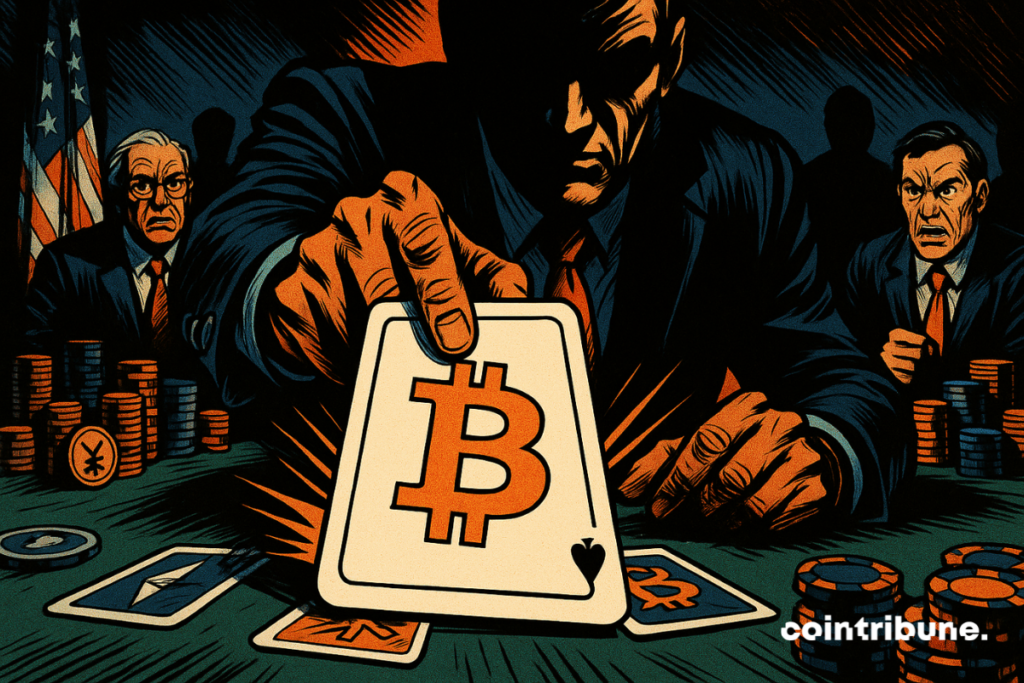Bitcoin: A Reliable Plan B for Investors Facing Inflation
Can we still deny the evidence? The role of institutional investors in recent bitcoin surges is now glaring. Gone are the days when this asset was reduced to a techno-fad or a libertarian utopia. Today, names like BlackRock or Fidelity fully integrate it into their strategies. Bitcoin has left the geeks’ garage to take its place in boardrooms. It’s official: the time for seriousness has come.

In Brief
- Bitcoin is now integrated into state reserves, including in the US Treasury’s strategy.
- It becomes an institutional pillar, with ETFs drawing billions and attracting BlackRock, Fidelity.
- States like Texas are creating public Bitcoin funds to strengthen their financial autonomy.
- Its rise is explained by its crisis resistance, scarcity, and compatibility with the digital world.
When the Great Fortunes Push Bitcoin to Wall Street
Bitcoin is no longer a speculative game for Reddit marginal players. Since early 2025, Bitcoin ETFs attract more than one billion dollars of inflows every day. Just the IBIT fund of BlackRock has accumulated more than 700,000 BTC, equivalent to over 83 billion dollars. A silent, yet massive offensive.
This shift is not only financial. It is also political. Since Donald Trump’s return to the arena, the crypto discourse has changed tone. The United States no longer fights cryptos, it regulates them to better integrate them. The US Treasury now holds bitcoin. The Genius Act regulates stablecoins and requires them to be backed by US Treasury bonds.
This structural change makes the dollar more exportable than ever.
This is not just a passing trend. Giants like Fidelity and dozens of pension funds diversify between 1 and 3% of their portfolios with crypto assets.
It is no longer a curiosity; it is now a cornerstone of financial architecture.
From Nations to States: When Bitcoin Enters Public Treasuries
This movement does not stop at Wall Street’s doors. It has reached the halls of power. In March 2025, the United States created a strategic bitcoin reserve, alongside gold and oil. Texas, Arizona, New Hampshire followed with their own funds, independent from federal Treasuries. Armed with Senate Bill 21, Texas stands out as a proud pioneer.
Why this turn? Because BTC offers what few assets guarantee during geopolitical turmoil: resistance to sanctions, digital resilience, and global mobility. During the war in Ukraine, NGOs raised more than 100 million dollars in bitcoin to bypass banking blockades.

In March 2023, the collapse of Silicon Valley Bank saw BTC climb 40%, while US banking stocks fell 25%. With every crisis, bitcoin gains credibility. It is no longer a wildcard: it’s a trump card.
Central banks, usually cautious, are watching closely. For some, bitcoin has become a signal of technological power. It shows that the country is ready for the finance of tomorrow.
David Sacks, the White House “crypto czar,” summarizes the American strategy as follows:
The U.S. will not sell any bitcoin deposited into the Reserve. It will be kept as a store of value. The Reserve is like a digital Fort Knox for the cryptocurrency often called “digital gold.”
Some Criticism, but a Crypto Revolution Too Well Oiled to Back Down
Yes, bitcoin remains volatile. Bob Elliott reminds us: “Since 2021, the performances of gold and BTC are close. But gold has 1/4 of the volatility and only 14% correlation with stocks, compared to nearly 60% for BTC“.
But what many forget is that bitcoin’s volatility is decreasing. Its annual inflation fell below 0.83% after the 2024 halving. The technical infrastructure is robust: 99.98% uptime, a 900 EH/s hashrate in 2025. No protocol hacks in 15 years.
Some Figures to Remember:
- Bitcoin shows an average performance of +165% per year since its creation;
- US ETFs draw more than one billion dollars per day in 2025;
- The United States officially hold Bitcoin in their national strategic reserve;
- The Lightning Network can process millions of transactions per second at minimal cost;
- Over 100 million dollars were transferred in Bitcoin to Ukraine during wartime.
Even if its adoption as a means of exchange remains limited, Layer 2 solutions like Lightning Network are game-changers. The main action takes place elsewhere: bitcoin has become a structural layer of the global monetary system. Whether its detractors like it or not.
Can we imagine bitcoin supplanting gold? Technically, it’s not impossible. But is that really the point? Constantly opposing these two assets hides a more unsettling truth: BTC is forging its own path. A path still long when looking at the numbers. It has just surpassed Amazon in market capitalization. The road to gold remains open… but it will take more than a tweet to get there.
Maximize your Cointribune experience with our "Read to Earn" program! For every article you read, earn points and access exclusive rewards. Sign up now and start earning benefits.
La révolution blockchain et crypto est en marche ! Et le jour où les impacts se feront ressentir sur l’économie la plus vulnérable de ce Monde, contre toute espérance, je dirai que j’y étais pour quelque chose
The views, thoughts, and opinions expressed in this article belong solely to the author, and should not be taken as investment advice. Do your own research before taking any investment decisions.